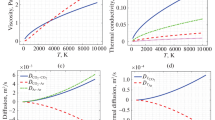Abstract
The vibrational temperature and vibrational deactivation time of CO molecules in collisions with hydrogen atoms are measured using the broadband version of the coherent anti-Stokes Raman scattering technique (CARS). Carbon monoxide with hydrogen-containing admixtures (H2, H2O) heated in a reflected shock wave up to temperatures 2900–5100 K escaped through a supersonic wedge-shaped nozzle. The measurements demonstrate the high efficiency of hydrogen atoms in the vibrational deactivation of CO. A difference in the measured temperature dependences of the vibrational excitation and deactivation times of CO molecules in collisions with H atoms, which seems to be associated with a difference in the mechanisms of CO-H complex formation, is noted.
Similar content being viewed by others
REFERENCES
P. V. Kozlov, V. N. Makarov, V. A. Pavlov, et al., "Use of CARS spectroscopy for studying the excitation and deactivation of nitrogen molecular vibration in a supersonic gas flow," Zhurn. Tekhn. Fiz., 66, No. 9, 43–57 (1996).
V. K. Dushin, I. E. Zabelinskii, and O. P. Shatalov, "Vibrational deactivation of molecular oxygen," Khim. Fiz., 7, No. 10, 1320–1327 (1988).
S. A. Akhmanov and N. I. Koroteev, Methods of Nonlinear Optics in Light Scattering Spectroscopy [in Russian], Nauka, Moscow (1981).
G. J. Rosasco, L. A. Rahn, W. S. Hurst, et al., "Measurement and prediction of Raman Q-branch line self-broadening coefficient for CO from 400 K to 1500 K," J. Chem. Phys., 90, 4059–4068 (1989).
K. P. Huber and G. Herzberg, Molecular Spectra and Molecular Structure. IV. Constant of Diatomic Molecules, Van-Nostrand-Reinhold Comp., New York (1979).
S. A. Losev and V. N. Makarov, "Theoretical investigation of processes in a carbon dioxide gasdynamic laser," Theoretical Investigations of Processes in Gasdynamic Lasers [in Russian], Moscow University Press, Moscow, 4–86 (1979).
L. S. Polak, M. Ya. Goldenberg, and A. A. Levitskii, Numerical Methods in Chemical Kinetics [in Russian], Nauka, Moscow (1984).
R. C. Millikan and D. R. White, "Systematics of vibrational relaxation," J. Chem. Phys., 39, 3209–3213 (1963).
M. E. Lewittes, C. C. Davis, and R. A. McFarlane, "Vibrational deactivation of CO (v = 1) by oxygen atoms," J. Chem. Phys., 69, 1952–1957 (1978).
C. W. Rosenberg, R. L. Taylor, and J. D. Teare, "Vibrational relaxation of CO in nonequilibrium nozzle flow, and the effect of hydrogen atoms on CO relaxation," J. Chem. Phys., 54, 1974–1987 (1971).
G. P. Glass and S. Kironde, "Vibrational relaxation of carbon monoxide in collisions with atomic hydrogen," J. Phys. Chem., 86, 908–913 (1982).
Rights and permissions
About this article
Cite this article
Kozlov, P.V., Makarov, V.N., Pavlov, V.A. et al. Experimental Investigation of Vibrational Deactivation of CO Molecules in a Supersonic Gas Flow. Fluid Dynamics 35, 926–932 (2000). https://doi.org/10.1023/A:1004152911281
Issue Date:
DOI: https://doi.org/10.1023/A:1004152911281



